We took a long break since our last Artist Study on Vincent Van Gogh, but we got back on track with our goal of covering 3-4 artists this school year. Henri Matisse has been a favorite of mine since I was a little girl. I can vividly recall seeing his masterpiece, One Thousand and One Nights, on a visit to the Carnegie Museum in Pittsburgh. I was eager to share my love for his vibrant paintings and bold collages with the boys.
We began our study much like the last one, but without the helpful Simply Charlotte Mason portfolio of pictures, because there is not one available for Matisse. Luckily, there are so many great resources appropriate for children. One of my favorite is the Usborne Book of Famous Paintings (disclaimer, that link is to my Usborne store, I finally became a rep after buying so many amazing homeschool books). You can see the book below; it is open to the page about Matisse's Harmony in Red. It has been a lifesaver for starting discussions about what to notice in paintings. Here we discussed the painting within the painting and how no one really know if it is a picture or a window because of the frame.
We set up our own still life with a table, a chair and lots of fruit. I encouraged the boys to add in some patterns in the style of Matisse rather than painting our plain gray walls. They also inserted a window/picture just like Matisse after a quick demo in which I illustrated the geometry Matisse used to make the three dimensional frame (two nesting rectangles with 45* lines at each corner).
We also used the Matisse from the Taschen collection as a reference book to view the vast illustrations of his work. Other than that we used picture books, and, boy, are there some fantastic ones out there on Matisse! The Iridescence of Birds by Patricia MacLaughlin was instantly deemed worthy of purchasing for our home library.
Another favorite picture book was Drawing with Scissors by Keesia Johnson and Jane O'Connor. This delightful book is told from the point of view of Keesia; she selected him to do school project on and the information about his life and art is relayed in a very engaging style.
We also read Colorful Dreamer by Marjorie Blain Parker and Henri's Scissors by Jeanette Winters. These both enhanced our study and were enjoyed by all.
I had every intention of ending our unit with a cutout collage project and we just ran out of steam. Our unit lasted about a month of twice weekly reading or painting, and everyone was ready to move on before we tackled it. Will requested Leonardo da Vinci for our next artist, so we will have a combo artist/scientist study next!






























